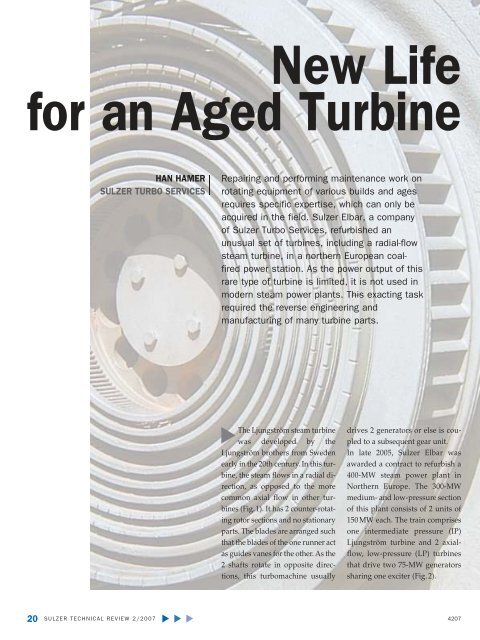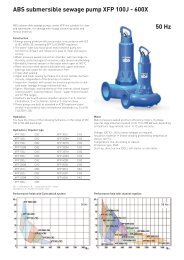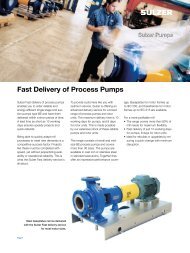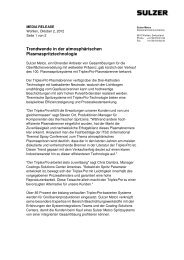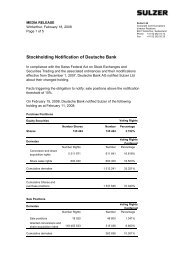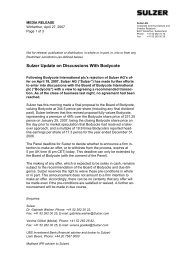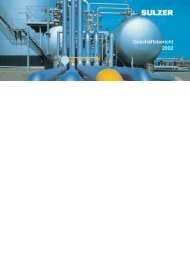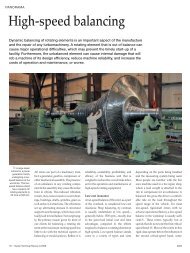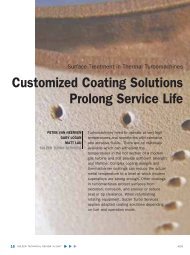HAN HAMER SULZER TURBO SERVICES Repairing and performing
HAN HAMER SULZER TURBO SERVICES Repairing and performing
HAN HAMER SULZER TURBO SERVICES Repairing and performing
Create successful ePaper yourself
Turn your PDF publications into a flip-book with our unique Google optimized e-Paper software.
New Life<br />
for an Aged Turbine<br />
20<br />
<strong>HAN</strong> <strong>HAMER</strong><br />
<strong>SULZER</strong> <strong>TURBO</strong> <strong>SERVICES</strong><br />
<strong>Repairing</strong> <strong>and</strong> <strong>performing</strong> maintenance work on<br />
rotating equipment of various builds <strong>and</strong> ages<br />
requires specific expertise, which can only be<br />
acquired in the field. Sulzer Elbar, a company<br />
of Sulzer Turbo Services, refurbished an<br />
unusual set of turbines, including a radial-flow<br />
steam turbine, in a northern European coalfired<br />
power station. As the power output of this<br />
rare type of turbine is limited, it is not used in<br />
modern steam power plants. This exacting task<br />
required the reverse engineering <strong>and</strong><br />
manufacturing of many turbine parts.<br />
The Ljungström steam turbine<br />
was developed by the<br />
Ljungström brothers from Sweden<br />
early in the 20th century. In this turbine,<br />
the steam flows in a radial direction,<br />
as opposed to the more<br />
common axial flow in other turbines<br />
(Fig. 1). It has 2 counter-rotating<br />
rotor sections <strong>and</strong> no stationary<br />
parts. The blades are arranged such<br />
that the blades of the one runner act<br />
as guides vanes for the other. As the<br />
2 shafts rotate in opposite directions,<br />
this turbomachine usually<br />
drives 2 generators or else is coupled<br />
to a subsequent gear unit.<br />
In late 2005, Sulzer Elbar was<br />
awarded a contract to refurbish a<br />
400-MW steam power plant in<br />
Northern Europe. The 300-MW<br />
medium- <strong>and</strong> low-pressure section<br />
of this plant consists of 2 units of<br />
150 MW each. The train comprises<br />
one intermediate pressure (IP)<br />
Ljungström turbine <strong>and</strong> 2 axialflow,<br />
low-pressure (LP) turbines<br />
that drive two 75-MW generators<br />
sharing one exciter (Fig. 2).<br />
<strong>SULZER</strong> TECHNICAL REVIEW 2/2007 4207
Sulzer Elbar had just 4 months to<br />
reverse engineer <strong>and</strong> manufacture<br />
over 500 different parts including<br />
consumables <strong>and</strong> major turbine<br />
components, such as labyrinth<br />
seals, hydraulic bolts, studs, <strong>and</strong><br />
axial pads for the thrust bearings.<br />
A specially formed engineering<br />
team completed this challenging<br />
task. The experts in the Sulzer<br />
Elbar laboratory analyzed material<br />
samples taken from the original<br />
turbine. The team prepared new<br />
drawings as well as manufacturing<br />
process documents <strong>and</strong> selected<br />
<strong>and</strong> qualified subcontractors.<br />
All parts had to be ready before<br />
on-site work began.<br />
Hazardous Chrome Replaced<br />
Overhaul of the steam stop <strong>and</strong><br />
regulation valves, including reverse<br />
engineering of the valve<br />
spindles, was a crucial part of the<br />
order. New techniques were applied<br />
for the manufacture of these<br />
components. The valve spindles<br />
were coated using the high-velocity<br />
oxygen fuel (HVOF) process,<br />
which replaces the normal elec-<br />
trolytic chrome process. The<br />
HVOF process enables the use of<br />
metallic powders with improved<br />
metallurgical properties. As a result,<br />
the new valve spindles perform<br />
better than the original ones.<br />
The steam stop <strong>and</strong> regulation<br />
valves were disassembled, inspected,<br />
<strong>and</strong> repaired in the Sulzer<br />
Elbar rotor shop. Of all 4 stop<br />
valves, the pilot valves had suffered<br />
the highest level of erosion.<br />
The old material was removed <strong>and</strong><br />
the seats were rebuilt with an<br />
improved hard-facing material.<br />
The valves were assembled with<br />
the new spindles <strong>and</strong> hardened<br />
bushes.<br />
Special Tools Designed<br />
The realignment of the units was a<br />
major issue due to their unique<br />
characteristics, age, <strong>and</strong> state of<br />
degradation. The alignment<br />
process necessitated the design of<br />
many special tools. After the alignment,<br />
assembly began (Fig. 3).<br />
During the assembly clearance<br />
checks, significant deformation of<br />
the steam chests was discovered.<br />
1 Sulzer Elbar carried out repairs on a steam turbine train containing an<br />
uncommon radial-flow steam turbine. The picture shows the rotor of this<br />
Ljungström turbine in the casing.<br />
1 2 3 4 5 6<br />
2 Schematic overview of the steam<br />
turbine <strong>and</strong> generator train with the<br />
Ljungström turbine in the center.<br />
The engineering department of<br />
Sulzer Elbar’s new-parts manufacturing<br />
group <strong>and</strong> the machining<br />
department worked around the<br />
clock on all 4 steam chests to repair<br />
<strong>and</strong> restore them to within operating<br />
tolerances.<br />
New Process Provides<br />
High Quality<br />
The refurbishment of the 4 lowpressure<br />
double-flow rotors was<br />
carried out in the Sulzer Elbar<br />
workshop in Lomm. This task included<br />
replacing the erosion<br />
shields of 8 sets of stage-6 blades<br />
<strong>and</strong> reducing the excessive clearance<br />
in the dovetail on the same<br />
stage. It was necessary to complete<br />
all this work within 4 weeks. The<br />
airfoil shop carried out the replacement<br />
of the erosion shields.<br />
To process 828 blades in the required<br />
period was an extremely<br />
difficult target to achieve. It was<br />
accomplished thanks to a new re-<br />
1 Exciter<br />
2 Generator<br />
3 LP turbine<br />
4 IP turbine<br />
5 LP turbine<br />
6 Generator<br />
3 Assembly of the<br />
radial turbine<br />
before installation.<br />
<strong>SULZER</strong> TECHNICAL REVIEW 2/2007 21
4 Removal of the<br />
generator rotor. pair process using an automatic<br />
laser welder. This process has<br />
great advantages in providing the<br />
highest level of quality <strong>and</strong> consistency<br />
for critical repairs.<br />
To solve the dovetail clearance<br />
problem, 2 steps were taken. Between<br />
the root of the blade <strong>and</strong> the<br />
rotor disc, a pin was inserted <strong>and</strong><br />
a new tie wire was brazed through<br />
the airfoils. These actions required<br />
extreme precision by the team <strong>performing</strong><br />
the task to ensure the correct<br />
temperature <strong>and</strong> thereby minimize<br />
material degradation from<br />
overheating. The tie wire replaces<br />
the top shroud of the blades,<br />
which was removed several years<br />
before after a failure. These measures<br />
limit the movement of the<br />
blades in the dovetail when the<br />
unit is running on the turning gear,<br />
<strong>and</strong> they thus reduce the wear in<br />
the root.<br />
5 Overview of both<br />
units after mechanical<br />
completion.<br />
22<br />
<strong>SULZER</strong> TECHNICAL REVIEW 2/2007<br />
Additional Work Carried Out<br />
At the customer’s request, Sulzer<br />
Elbar manufactured new erosion<br />
protection shields for the preheaters<br />
in the condenser within<br />
only 5 weeks.<br />
The generators are hydrogencooled<br />
units. First, Sulzer Elbar inspected<br />
them in situ (Fig. 4). Second,<br />
following the inspection of<br />
the bearings, the H2 seals had to be<br />
reverse engineered <strong>and</strong> replaced.<br />
Then, comprehensive stator electrical<br />
tests were performed. The<br />
wedges <strong>and</strong>, after removing the rotors,<br />
the end-bell were inspected.<br />
During operation, considerable<br />
amounts of hydrogen leaked from<br />
the generators, which had not<br />
been operating to their design<br />
specifications for many years. A<br />
main target of this outage was to<br />
reduce the leak rate down to that<br />
of the original design. A major issue<br />
was to change the O-ring <strong>and</strong><br />
the pressure ring of the vertical<br />
flange between turbine casing <strong>and</strong><br />
generator stator, which had to be<br />
lifted from its foundation in order<br />
to replace the O-ring.<br />
Leakage Reduced<br />
Another challenge was to replace<br />
all of the hydrogen shaft seals on<br />
the generators. The seals <strong>and</strong> covers<br />
were reverse engineered <strong>and</strong><br />
manufactured using the new<br />
plans. The Sulzer Elbar team succeeded<br />
in reducing the leak rate on<br />
both units to the original design<br />
criteria. The client can now operate<br />
the generator under normal<br />
pressure, a condition that had been<br />
impossible for the last decade. Following<br />
final assembly, the unit<br />
was field balanced to bring all vibration<br />
responses into specification<br />
(Fig. 5).<br />
Repair Specialists<br />
When it comes to repairing nonst<strong>and</strong>ard<br />
turbomachinery, the specialists<br />
at Sulzer Elbar can draw on<br />
experience from many projects.<br />
They displayed engineering<br />
knowledge <strong>and</strong> project management<br />
skills <strong>and</strong> finalized a very<br />
challenging project successfully<br />
despite intense time pressure <strong>and</strong><br />
significant on-site problems that<br />
required an extension of the<br />
agreed scope of work. The ability<br />
of Sulzer Elbar to manufacture<br />
new parts for old machines makes<br />
it possible to repair machines that<br />
would have previously had to<br />
have been scrapped.<br />
Contact<br />
Sulzer Elbar<br />
Han Hamer<br />
Spikweien 36<br />
5943 AD Lomm<br />
The Netherl<strong>and</strong>s<br />
Phone +31 77 473 8576<br />
Fax +31 77 473 8559<br />
han.hamer@sulzer.com


